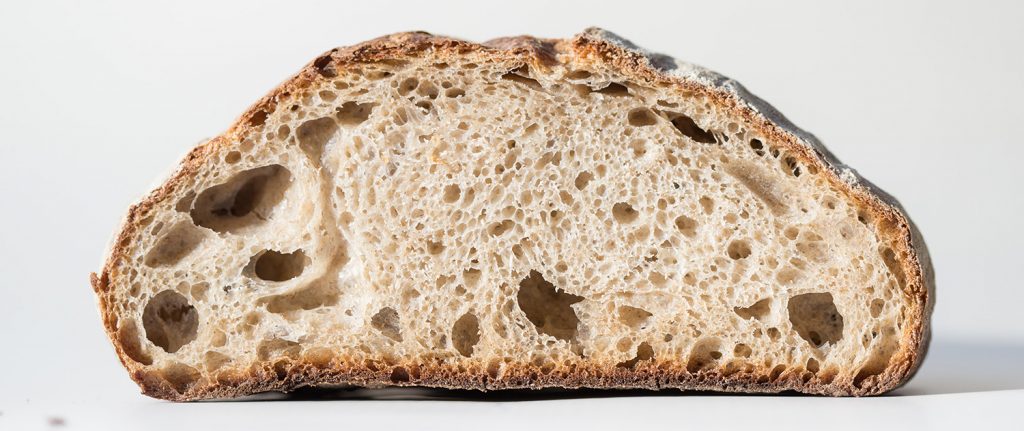
Editor’s Note: This is a guest post by Lauren Nichols, a researcher and lab manager in NC State’s Department of Applied Ecology – and manager of the new Wild Sourdough project. Whether you’re a long-time enthusiast, or a recent convert, the project is hoping to recruit sourdough bakers to solve some millennia-old mysteries.
As bakeries across the country close and commercial yeast has become scarce on store shelves, people have started paying more attention to a widely available yet understudied source of leavening: wild microbes. You may know it as sourdough.
There are millions (and potentially trillions) of kinds of bacteria and fungi on Earth. Yet if you mix milled grain (such as wheat flour) and water, the community of living things that colonize the resulting concoction is almost always composed of a small handful of organisms that are able to leaven bread, yielding a sourdough starter. How this happens remains unclear. This mystery is at the heart of bread making, but also the origins of the many pre-agricultural societies dependent on fermentation.
Bakers have understood how to make starters for at least 6,000 years and potentially much, much longer. Yet, the underlying biology of the species involved is just beginning to be studied. In this way, sourdough starters are emblematic of fermented foods more generally, whether that be kimchi, kombucha, sausage or sauerkraut.
Responding to requests from aspiring bakers for instructions on harnessing microbes to make bread, researchers in NC State’s Department of Applied Ecology, in partnership with other universities, bakeries, culinary schools, institutes and museums are launching a new project, Wild Sourdough. The goals of the new project are threefold: to guide bakers (and aspiring bakers) around the world through the process of making a sourdough starter; to gather meaningful data about the biology of the microbes that colonize sourdough starters; and to create a global virtual community centered around microbes and food.
“We want to do more than science here, we want to build community,” says Rob Dunn, one of the scientists involved in the effort. “Our hope is that in making starters as part of a common project that people can come together, virtually, around food, science, heritage and flavor.”

On their website and through social media, the scientists guide bakers through making starters under different conditions, using different types of flour or in different environments within a baker’s home. Once bakers have starters, they collect data to characterize their starter: how fast the new starters rise and the aromas they produce.
“People don’t need expensive lab equipment or fancy degrees to do real science,” explains Erin McKenney, a researcher on the project. “The measurement might seem simple and even low tech, but these are data that we could never gather without the help of the public.”
Participants will be helped through this work by a series of mini-seminars on fermentation. One seminar, by baker Peter Reinhart (author of The Bread Baker’s Apprentice and five other books about bread), will focus on baking bread. This will be followed by a seminar by Michael Kalanty (author of How to Bake Bread and former director of the California Culinary Academy) on how to taste the bread that has been made. And later there will be a seminar by Margarita López-Uribe on the unusual (pollen) bread made by bees.
There will be more than 20 such seminars in total, all linked to telling the broader story of fermentation – from evolution to chemistry, to history and anthropology.
Through this effort, participants and scientists will work together to take measurements that, collectively, lead to new discoveries about the biology of sourdough starters.
Individually, these measurements can tell us a little bit about the biology of starters; but collectively, once we have data from sourdoughs across the world, we can start to make bigger discoveries about how geography and environment impact the microbes in sourdough starters.
For example, how much influence do the type of flour, the temperature and the region have on the kind of sourdough starter that can be made?
The Wild Sourdough project builds on the ongoing collaboration between participants and scientists in the Global Sourdough Project, which aims to understand pre-existing sourdough starters from across the world and identify the microbes living in those starters.
“In these uncertain, fearful and isolating times, creating a sourdough starter and baking bread gives us the opportunity to partner with microbes to create something soothing, nourishing and lovely,” says Anne A. Madden, a scientist involved with the project.
And who wouldn’t want that?
To learn more about the Wild Sourdough project, including how you can get involved, please visit the project page at http://robdunnlab.com/projects/wildsourdough/ and join the Wild Sourdough Facebook group.
This post was originally published in NC State News.